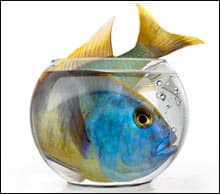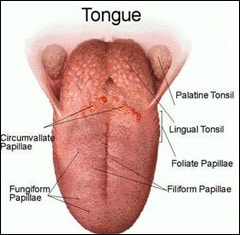Location, location, location

Because of the stress placed on the TMJ, a variety of symptoms may develop, such as headaches, tingling in your fingers and back of your hand and pain in your neck or shoulders.
Here’s another trick. Place your little fingers, pads forward, in your ear canals and gently pull forward. Open and close your teeth. Do you feel any clicking, clicking or clicking? That’s a stressed TMJ.
Your jaws are NOT “hinging”…
Contrary to what you might imagine, your jaw joint isn’t a hinge. There is an assumption that a jaw joint operates similar to a door hinge; moving along as it’s required. Instead, your jaw joint is more like a ball. Your joint rotates and slides forward or backward and can even swing from side-to-side. Your jaws are NOT connected bone-to-bone. There ligaments and soft tissue there as well.
Breathing, Tongues and Balance

Many TMJ problems start when you were a small child and continued as you grew. One of the major causes of TMJ in adults are breathing issues as a child. The most important need we have is to breath. We may go without food and water for a day or two, but we can hold our breath for less than a minute. Breathing is our bodies primary need always. In a child, allergies, enlarged tonsils and adenoids, blocked nasal passages all contribute to difficulty breathing through the nose.
If the child cannot breath through their nasal passage they will breath through their mouth. Problem solved? Not really. Chronic mouth breathers require that their tongue sit low in the mouth so air can pass over it on the way to the lungs. Normally the tongue will rest up behind the upper teeth near the roof of your mouth. Why is this important? The tongue is a large powerful muscle. It is important for the development of the upper jaw during growth. The tongue’s function is to create a balancing force to the inward pressure of your lips and cheeks. Lips and cheeks push in on the upper jaw, tongue pushes out. Everything is in balance during growth.
Mouth breathers will not have balance and the resulting growth will not be to the child’s genetic potential but instead show a narrowing of the upper jaw. Instead of the upper jaw being shaped by the “U” shape tongue muscle, the lips and cheeks squeeze the upper jaw into a “V” shape. The worse the mouth breathing, the more “V” shape the upper jaw. The lower jaw is not under these same growth imbalances. The lower jaw usually forms in the genetically determined “U” shape.
When you have an imbalance in your bite . . .
- Your upper jaw is shaped in a V.
- Your lower jaw is shaped in a broad U.
- Your upper and lower jaws don’t have the same shape.
For your jaw to work properly, every time you open and close your mouth, your lower jaw needs to move back to where it’s wider. Your jaw joint rotates and slides back and up. Your jaw’s up and back movement compresses your jaw joint into it’s socket or “fossa”. This fossa sits just in front of your ear. If you place your little finger in your ear, finger pad forward and open and close your mouth, biting on your back molar teeth, you may feel how your little finger is squeezed by the movement of the lower jaw going back and up into the fossa.
Everything is connected …
There are a series of muscles, nerves, tendons that connect the jaw with other bones of the skull and neck. So if your upper and lower jaws that aren’t compatible all of your muscles, tendons and nerves in the entire head and neck system must accomodate. Every time you bring your teeth together to chew, bite, swallow, talk, sing, etc – your jaw is strained, trying to create balance and control.
With even a slight imbalance in your bite, over time you will start to see significant problems.
What else does your tongue do?

Besides the interesting trivia, your tongue is imperative to your health. Here’s the deal:
1 Your tongue is attached to your lower jaw and when you have imbalance in your bite, it essentially acts as a pillow. It’s used as a cushion to help relax your jaw. This resting on your lower back teeth often tips the lower back teeth inward, further changing the function of the jaws with each other. This often leads to gum loss around teeth as a consequence of unbalance alignment of upper and lower teeth.
2 Your tongue lives in the space created by your upper and lower teeth. When you bite together, that box created by the position of your teeth is all the room your tongue has. Sometimes it is not enough.
When you have imbalance or disproportions in your bite, your tongue simply doesn’t have the room to fit in your mouth. It’s like parking a Cadillac in a garage designated for a Yugo. When your Cadillac tongue is parked in your Yugo mouth, it will lead to improper tongue placement. The only way for the tongue to go is back and that can lead to blocked and restricted air passages. Tongue posture is a major factor in Obstructive Sleep Apnea.
